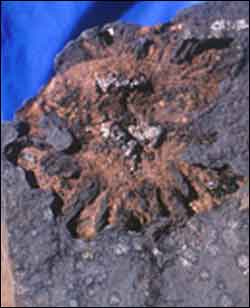Queen’s discovery sheds new light on ancient temperatures

A new discovery by a team of Queen’s University scientists suggests that ancient earth was much colder than previously thought – a discovery that has broad implications for those studying the earth’s climate.
Queen’s researchers have discovered the mineral ikaite in 700-million-year-old marine sedimentary rocks in the Mackenzie Mountains of the Northwest Territories and eastern Yukon. This discovery proves that the ancient ocean was much colder than previously believed, says Noel James of Queen’s department of Geological Sciences and Geological Engineering. It has caused scientists to rethink what they know about the temperatures of ancient earth and possible atmospheric conditions at the time.
“One of the main thrusts of our research is trying to unravel the ancient history of the planet,” says James. “If we understand what has happened in the past and how the earth has responded and recovered, it will give us some idea of how the world will respond to some of the things that are happening to it now.”
The researchers discovered ikaite at several different levels in what were believed to be rock formations deposited in shallow, warm oceans during the interval between two ice ages that extended all the way to the equator millions of years ago. But ikaite forms in shallow water on the sea bottom at cold temperatures and melts when brought to the surface. The fundamental question for scientists is what triggered the enormous ice ages that left the oceans cold enough for the formation of this mineral?
One controversial theory known as “The Snowball Earth” hypothesis suggests that around 700 million years ago the earth was almost totally enclosed in ice. The Queen’s discovery offers alternatives to this hypothesis. Glaciers wax and wane according to how the earth’s orbit changes relative to the sun and how much solar radiation reaches the earth over a given time, says James. Was there a major celestial change that allowed the oceans to become so much colder during this period, or was there a change in the composition of the atmosphere that no longer allowed solar radiation to heat the surface of the earth?
The Queen’s study suggests that an overpopulation of ancient marine plants may have removed carbon dioxide from the atmosphere and created extreme cold that caused the earth’s temperature to fall, and this would be reflected in the composition of the rock.
Queen’s earth scientists including Dr. James, Guy Narbonne, Robert Dalrymple and Kurt Kyser are using chemical analysis to determine the precise attributes of the rocks and further pursue the study of the ancient environment at this time in earth’s history. These measurements are being completed at the Queen’s Facility for Isotope Research, one of the best in North America.
The research is funded by NSERC Discovery and Major Facilities Access grants, Canada Foundation for Innovation and Ontario Innovation Trust.
For more information contact Lorinda Peterson, 613.533.3234, petersn@post.queensu.ca or Nancy Dorrance, 613.533.2869, dorrance@post.queensu.ca, Queen’s News and Media Services.
Media Contact
More Information:
http://www.queensu.caAll latest news from the category: Earth Sciences
Earth Sciences (also referred to as Geosciences), which deals with basic issues surrounding our planet, plays a vital role in the area of energy and raw materials supply.
Earth Sciences comprises subjects such as geology, geography, geological informatics, paleontology, mineralogy, petrography, crystallography, geophysics, geodesy, glaciology, cartography, photogrammetry, meteorology and seismology, early-warning systems, earthquake research and polar research.
Newest articles

High-energy-density aqueous battery based on halogen multi-electron transfer
Traditional non-aqueous lithium-ion batteries have a high energy density, but their safety is compromised due to the flammable organic electrolytes they utilize. Aqueous batteries use water as the solvent for…

First-ever combined heart pump and pig kidney transplant
…gives new hope to patient with terminal illness. Surgeons at NYU Langone Health performed the first-ever combined mechanical heart pump and gene-edited pig kidney transplant surgery in a 54-year-old woman…

Biophysics: Testing how well biomarkers work
LMU researchers have developed a method to determine how reliably target proteins can be labeled using super-resolution fluorescence microscopy. Modern microscopy techniques make it possible to examine the inner workings…





















